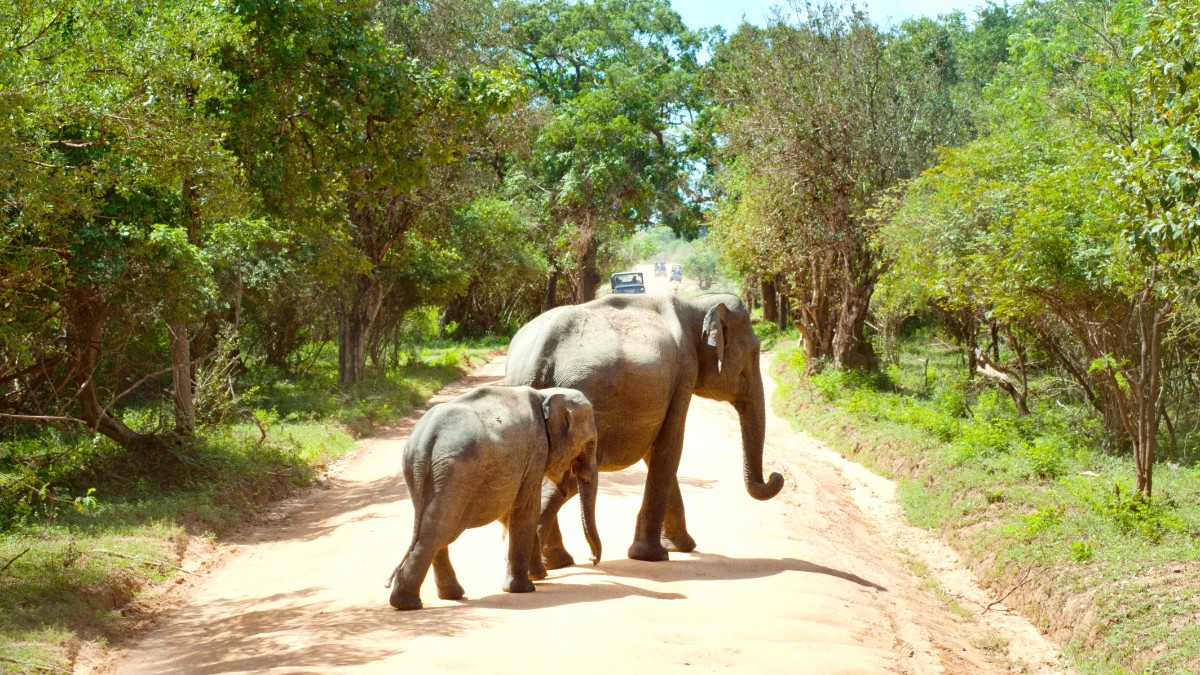
The South, Sri Lanka
Yala National Park is the main draw, famous for its animal populations. It is renowned for its high density of leopards, considered one of the highest in the world. It also hosts numerous elephants, sloth bears, and diverse birdlife.
Sithulpawwa Rock Temple, an ancient Buddhist monastery within Yala National Park (Block 1), holds historical significance, believed to have housed 12,000 monks in ancient times.
For tickets and tours, you can check platforms like GetYourGuide.
Use a telephoto lens (300mm or more is recommended) for close-up wildlife shots. Be prepared for dusty conditions; protect your camera equipment.
Avoid using flash on animals, as it can disturb them.
Maintain a respectful distance from all animals. Avoid loud noises, and never attempt to feed or approach them.
Always stay inside the safari vehicle unless explicitly permitted by your guide at designated safe areas.
Specific waterholes or rocky outcrops within the park offer good viewing opportunities.
The Yala area focuses mainly on natural attractions and ancient sites rather than traditional museums.
There are no major museums directly associated with Yala National Park or its immediate surrounding towns.
Are not present in the Yala area.
Are not found. Luxury resorts might arrange occasional cultural performances for guests.
Are not a feature of this region.
Are not a standard offering in this region.
The region's attractions concentrate on natural beauty and historical sites.
The Kataragama Temple Complex is a highly revered multi-religious pilgrimage site, featuring temples dedicated to Lord Kataragama, Ganesh, Vishnu, and a mosque. Daily Poojas (offerings and ceremonies) happen multiple times a day.
Sithulpawwa Rock Temple, an ancient Buddhist monastery within Yala National Park, features ruins and stupas and offers panoramic views. Magul Maha Viharaya, near Yala, is known for its well-preserved moonstone and historical significance.
Tissamaharama town features the Tissa Dagoba, a large ancient stupa, and Tissa Wewa, a large ancient reservoir. Both are significant historical sites related to the Ruhunu Kingdom.
Kiri Vehera is a large, ancient white stupa located within the Kataragama complex. It is another important site for pilgrims.
Beyond the national park, the region offers other natural wonders.
Venture beyond the most obvious attractions to discover more of the region's charm.
Explore Yala National Park (Blocks 3, 4, 5) for a wilder, less-crowded safari experience. Kumana National Park, east of Yala, offers similar wildlife but sees far fewer visitors.
Explore some of the smaller village temples or local markets around Tissamaharama and Kataragama. These offer a genuine look into daily Sri Lankan life without the tourist crowds.
The development of Mattala Airport (HRI) has brought some attention to the wider Hambantota district. However, tourism in the area still mainly concentrates around Yala National Park itself.
Book your Yala National Park safari tickets and tours seamlessly.
Find your safari adventure on GetYourGuideDiscover the historical and cultural significance of sites like Sithulpawwa Rock Temple and Kataragama Temple Complex.
Explore historical tours on GetYourGuideGain a comprehensive understanding of various wildlife encounters, including bird watching and less-visited park blocks.
Discover wildlife experiences on GetYourGuideLearn about the beautiful Yala coastline and nearby beaches, offering serene landscapes.
Coastal trips on GetYourGuideFind options for combining cultural sites with nature excursions for a complete visit.
Full-day tours on GetYourGuideThis section details the must-visit landmarks, natural wonders, and hidden gems that complete a visit to Sri Lanka’s south.
Prepare to explore ancient temples, observe diverse wildlife, and discover scenic landscapes.
The main natural attraction, renowned for its high density of leopards, elephants, sloth bears, and diverse birdlife. Block 1 is the most popular.
A Ramsar wetland site and important bird area, west of Yala. Known for significant bird populations, elephants, and crocodiles. Generally less crowded than Yala.
Borders Yala and serves as an elephant corridor. Less developed for tourism than Yala, it provides a more rustic safari experience with good elephant sightings.
Patangala in Yala National Park offers views of the coastline. Tissa Wewa, the ancient lake in Tissamaharama, is popular for evening strolls and bird watching, especially at sunrise or sunset.
Find views on GetYourGuideLarge granite rock outcrops, known as kopjes, characterize Yala National Park’s landscape, adding to its rugged beauty.
Discover natural wonders on GetYourGuideKirinda Beach is a rugged, often deserted beach. Parts of Yala National Park border the Indian Ocean, offering stunning coastal landscapes and photo opportunities.
Explore beaches on GetYourGuideBlocks 1 and 5 in Yala National Park are popular for safaris. Bundala National Park is excellent for birdwatching. Lunugamvehera offers a secluded safari experience.
Book wildlife tours on GetYourGuideThis section details the must-visit landmarks, natural wonders, and hidden gems that complete a visit to Sri Lanka’s south.
Prepare to explore ancient temples, observe diverse wildlife, and discover scenic landscapes.
Kirinda Beach offers rugged beauty, Yala Coastline stunning coastal views, and granite kopjes add to the park's ruggedness.
Palatupana offers glimpses of fishing communities. Tourism is concentrated around Yala NP.
Typically 6:00 AM - 6:00 PM daily. Morning (6-10 AM) and Afternoon (2-6 PM) sessions available. Full-day safaris are also an option.
Foreign Adult Entry: US$25-30. Jeep Entry Fee: US$10-15. Tracker Fee: LKR 1,500 - 2,000 per jeep. Safari Jeep Rental: LKR 6,000-25,000 per jeep. (Subject to change).
All safari jeeps include a driver and a DWC tracker. Consider platforms like GetYourGuide for booking tickets and tours.